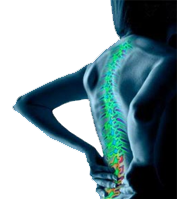Osteopathy
There are two kinds of physicians that practice medicine in traditional medical clinics and hospitals in the United States: allopathic physicians, and osteopathic physicians. Allopathic physicians have the title of “M.D.” and osteopaths have the title “D.O.” You will find both working side by side in medical settings everywhere.
Osteopathic medicine is a distinctive form of medical care founded on the philosophy that all body systems are interrelated and dependent upon one another for good health. This philosophy was developed in 1874 by Dr. Andrew Taylor Still, who pioneered the concept of “wellness” and recognized the importance of treating illness within the context of the whole body. In our opinion, an osteopathic evaluation is just a very detailed way to evaluate the movement and function of the musculoskeletal and nervous systems of the body. It involves the extensive use of palpation and range of motion testing of the muscles and joints of the body.
Osteopathic physicians use all of the tools available through modern medicine including prescription medicine and surgery. They also incorporate osteopathic manipulative medicine (OMM) into their regimen of patient care when appropriate. OMM is a set of manual medicine techniques that may be used to diagnose illness and injury, relieve pain, restore range of motion, and enhance the body’s capacity to heal.
What is somatic dysfunction?
Somatic dysfunction is the impaired or altered function of bodily structures. The osteopathic evaluation is focused on identifying areas of the body in which the muscles, bones and nerves “are not playing well with each other”. During an osteopathic based exam, the examiner is looking for:
- Range of motion asymmetries between sides of the body or corresponding body parts
- Loss of motion of the joints
- Tissue texture abnormalities in the soft tissues surround the joints
The physician uses techniques such as layer-by-layer palpation and intersegmental range of motion testing to make the diagnosis. Diagnosis usually requires only the use of the physician’s hands and fingertips, though instruments can be used to detect a diminished range of motion.
The hallmark of a musculoskeletal somatic dysfunction diagnosis involves the detection of a “restrictive barrier” related the structure in question. The language of “barriers” refers to the point at which a structure cannot move further in a given direction. For example, a natural “physiologic barrier” of the arm represents the farthest that a person can naturally move their arm before it cannot be comfortably moved further. The “anatomic barrier,” then, is how far the arm can be pushed or pulled by an outside force before the arm becomes physically injured. A “pathological” or “restrictive” barrier represents the shortened range of motion to which the arm is confined because of an injury, spasm, or some other somatic dysfunction. The goal of treatment, then, is to restore the arm’s range of motion (or that of whatever structure is in question).
Other types of somatic dysfunctions may include occlusions or mutilations of vasculature or lymphatic vessels, which can impair cardiovascular or lymphatic circulation. This may also occur secondary to organ pathology, a factor which theoretically allows the detection of visceral dysfunction by examining surface structures.
Somatic dysfunction and dysfunctions can accumulate over time and led to pain. OMT attempts to restore normal function and break a vicious cycle that can develop in many unfortunate patients. A return to normal physiological status both in the spinal tissue and the organ tissue generally ensues except when complicated by the presence of major infection or significant physical trauma. The clinical picture will vary from patient to patient, but the phenomena are based on sound neurological principles.
What is Osteopathic Manual Therapy?
OMT is a variety of different techniques that attempt to treat somatic dysfunction. They include, but are not limited to:
- Muscle Energy Techniques
- High Velocity, Low Amplitude (HVLA) thrusts
- Counterstrain
- Myofascial release
- Functional Indirect
- Cranial Osteopathy



